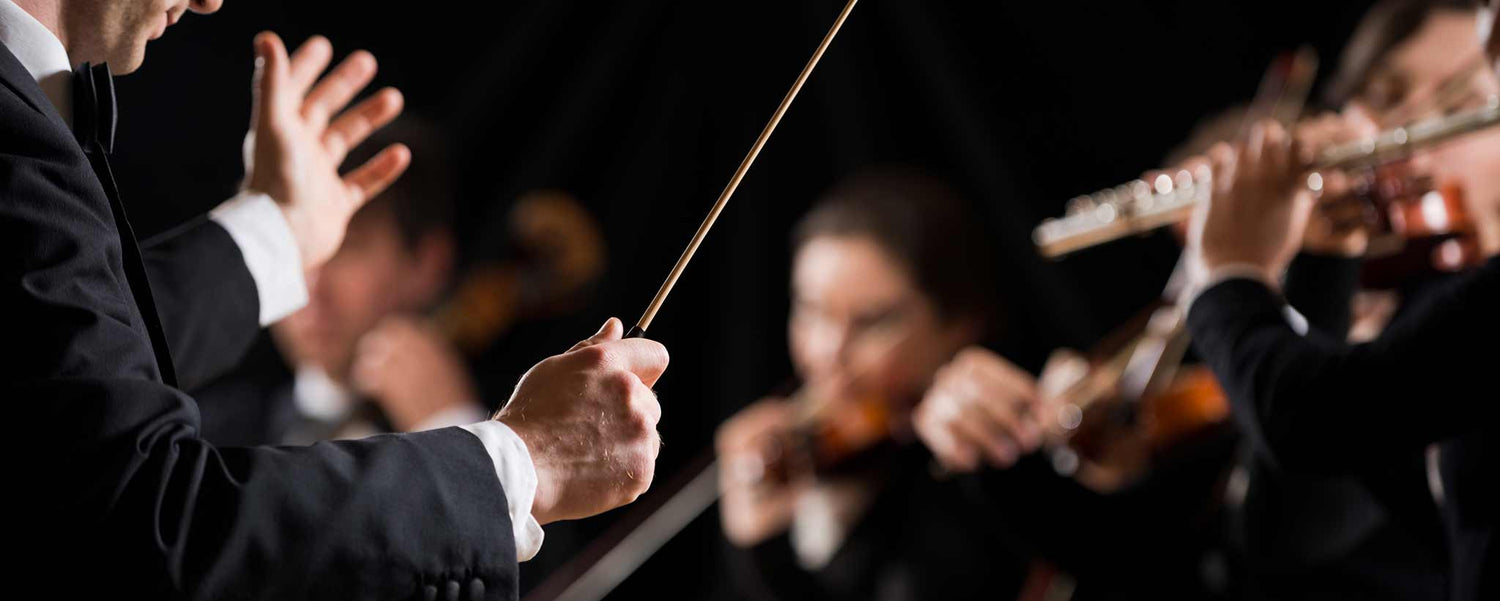This vivid narrative describes vertiginous migraine symptoms with orchestral language. Then it uncovers a mysterious trigger.
Senses Intensify To Heighten Performance
I am still feeling the effects of the inundation with migraines from last week. To most people, this means a bad headache of some kind. You might imagine the classic sharp piercing sensation on one side of the head. [1] However, the description varies among patients.
How does a migraine feel? To get an answer, you’re invited to this orchestration identified by some neurologists and otolaryngologists as vertiginous or transformed migraine. Shhhhhush. The performance is about to begin.
Conductor Taps Baton
All euphonic compositions have a cue. Tapping on the podium, with the grip of the baton nestled between the thumb and first two fingers, the conductor pauses after raising his hands. The mute orchestra is transfixed as musicians await his slightest movement. The migraine symphony commences.
Awakening later than usual, I feel unrested with the sensation of a heavy head. Pressure increases somewhere beyond the depths of a squinting eye, while the other open eye attempts to distinguish blurry digits on the clock. The faint notion of rotating my face to the other side on my pillow to alleviate the discomfort becomes an unpleasant score.
Rating 6 out of a possible 10 on a pain scale, my migraine has not yet peaked, but it is definitely uncomfortable. This is my aura—a foreboding that the orchestra of unpleasant talents has assembled. Almost 80% of migraine patients have no aura. My most optimistic hope is that I will feel well enough to attend an engagement of a different kind much later in the evening.
Migraineurs must read the baton gestures correctly so as not to get caught in a complex arrangement like automobile traffic or other bright and loud public places when the full-blown symptoms play out. Don’t let someone force your hand with pleas that they need you if you realize you will soon become incapacitated. Cancel appointments for the day.
A Brief Interlude
Staggering to the kitchen, I forage for any remedies available in a futile attempt to prevent the inevitable. Most medications are best taken daily as a preemptive measure. That’s something I avoid because of the relative infrequency of my attacks. Once the cacophony begins, most natural and some pharmaceutical options are inconsequential. It’s like requesting a concert ticket refund after you’re already seated.
In professional concert halls, food and drink are not allowed. Should I try a Feverfew capsule or a prescription? With restraint, I choose the herbal option. A swallow of water concludes my breakfast since I cannot think of food, let alone prepare anything.
The First Performance

Meandering down the hallway with apparent disequilibrium, I compose my orchestra pit. Shades are drawn tightly before burying myself beneath all the soft pillows I can gather. Now the sense of hearing is heightened. Otolaryngologists call this hyperacusis or sonophobia.
I am reminded of how Gustavo Dudamel demonstrated the superior acoustics of the Walt Disney Concert Hall by having an LA Philharmonic percussionist softly drag his finger across a drum as part of the spectacular orchestral arrangement.
My wife rubbing lotion on her arms becomes soft violins in the strings section. There’s the abrupt baritone of a clearing throat in the brass section. Sliding clothes hangers are a crescendo of bells and clashing symbols.
The periodic woodwind of pressure squishing deep within my tympanic cavity completes the symphony. A soft peck on the cheek with no verbal, “Goodbye,” is the preferred decrescendo for my wife’s morning departure as I slip back into slumber.
The Second Performance
When my eyes reopen, it’s past noon. The pain has reached level 8 during this intermission. The ringing in my ear suggests that the orchestra played at full volume while striking my head with a sliding trombone. My ability to concentrate or articulate has dropped to nearly 30 percent, and that left eye is still closed.
A trip to the restroom coincides with a hunt for prescription pills. It may be as futile as reaching the high musical notes of a flute with a double bass. Optimistic of relief with stronger meds in my system, I slide beneath the covers as the conductor raises his baton for the next performance.
The Third Performance
It’s mid-afternoon before I awaken again. Nausea has joined my migraine for a double concerto. I prepare some ginger tea to sip while checking online updates. Thankfully, there are no messages requiring complete thoughts. I’m off to sleep again.
The Final Performance
By 5:18 PM, with less than two hours left to attend my evening engagement, the hyperacusis and nausea had reached the end of their sheet music. Photophobia (light sensitivity) is somewhat lessened as nightfall arrives. There’s less intense pressure on the left side of my head (like the residual effects of being smacked in the temple with a trombone).
After a half hour of email responses on a mobile device, I rouse enough strength to shower, shave, get dressed, and drive to the meeting with 70 percent lucidity. My presence is beneficial, though participation is limited by discomfort.
Migraine Concession Stand
Foods That May Trigger Migraines [2]
- Olives
- Tomato
- Onions
- Breads
- Nuts
- Soy products
- Cheese
- Cultured dairy
- Chocolate
- Beer
- Wine
- Vinegar
Generous water consumption throughout the day dilutes potential triggers. Consuming multiple triggers with inadequate hydration concentrates on the negative effects.
Upon my return home, it’s too late for dinner. So I head to the concession stand for popcorn while catching up on email. At 11:30 PM, my headache is finally gone. As the symptoms wear off, it is common to evaluate what may have been the trigger or if there was an earlier sign.
I recall, during the prior evening, lowering the volume on my car radio as my ears were more sensitive than usual. Can’t do much more thinking now. Even though I slept most of the day, my body is exhausted.
The conductor takes his bows along with the various orchestral sections. This was the second show this week. Hopefully, there are no encore performances tomorrow, as these headaches have been known to cluster (migrainous neuralgia). Scientists do not know exactly what causes cluster headaches, but they appear to be related to the body’s sudden release of histamine or serotonin. [3]
Season Tickets
As mentioned, patients experience different types of migraines. For some, distinct aura symptoms may include one or more of the following: flashes of light, blind spots (scotomas), brief vertigo, numbness, typically felt as tingling in one hand or on your face, difficulty with speech or language, or muscle weakness.
Migraine triggers can be food allergies, sounds, smells, certain medications, emotional stress, environmental toxins, or even teeth grinding. Some migraineurs endure nearly constant pain, while others experience less frequent episodes averaging once a month or so. Fortunately, mine are infrequent (except for when they cluster).
| Migraine Type | Typical Characteristics [4–6] |
|---|---|
| Migraine with Aura (MWA) | Lasting from 10 to 30 minutes, an aura is a series of visual, sensory, and cognitive changes that precede a migraine headache. |
| Migraine Without Aura (MWOA) | Lasting from 4 to 72 hours, throbbing or pulsating pain is most often one-sided, and it is generally accompanied by nausea or vomiting. |
| Hemiplegic Migraine | More common in children, symptoms include slurred speech with temporary paralysis on one side of the body, reminiscent of a stroke, prolonged aura, vertigo, or sensation of one's surroundings spinning, muscle incoordination, impaired consciousness, generally accompanied by a headache about 10 to 60 minutes later. |
| Basilar Migraine | Begins with impaired speech, loss of balance, double vision, temporary loss of sight, weak muscle control, and confusion, normally lasting up to 60 minutes, accompanied by an intense headache at the base of the skull. Caused by dilation of the basilar artery, frequently appears in young women throughout the week leading up to menstruation. |
| Abdominal Migraine | Typical migraine headache signs and symptoms other than the head pain. Rather, the patient experiences abdominal pain. |
| Ophthalmoplegic Migraine | Malfunction of the ocular-motor and abducens nerves results in pain focused around the eyes. Other symptoms include droopy eyelids, bigger pupils, as well as double vision. More common in children. |
| Status Migrainous | It may last from 72 hours to weeks, often activated by several pain medications. Sufferers are frequently hospitalized to help overcome the accompanying nausea and vomiting. |
Less common forms of migraine, such as acute confusional migraine of childhood, vertiginous migraine, and nocturnal migraine, remain unclassified by the IHCD-II.
As a recovering caffeine consumer, my treatment of choice is freshly brewed coffee. It sometimes helps during the second performance of an all-day migraine bout. Interestingly, caffeine can be both a trigger and a remedy. An encore that spills into a second day is also an excuse for a cup of black java. When there are three episodes in one week, two cups of coffee are elevated to my first line of defense.
If there is an increase in the frequency or intensity of your typical migraines, talk to your doctor. He or she may just have the wonderful Migraines and Headaches poster in the office. I have compassion for fellow migraineurs, regardless of the specific type. Let me know how you deal with migraines in the comments below.
To support the writing of useful articles about neurology, ClinicalPosters sells human anatomy charts, scientific posters, and other products online. You may sponsor specific articles, become a ClinicalNovellas Member, or remit a small donation.
ClinicalPosters sells human anatomy charts, scientific posters, and other products online to offset expense of the writing useful articles about neurology. Slide extra posters into DeuPair Frames without removing from the wall.
Show your support by donating, shopping for ClinicalPins, becoming a ClinicalNovellas Member, or leaving an encouraging comment to keep the research going.
To support the writing of useful articles about neurology, ClinicalPosters sells human anatomy charts, scientific posters, and other products online. You may sponsor specific articles or remit a small donation.
ClinicalPosters sells human anatomy charts, scientific posters, and other products online to offset expense of the writing useful articles about neurology. Slide extra posters into DeuPair Frames without removing from the wall.
ClinicalPosters sells human anatomy charts, scientific posters, and other products online. You may remit a small donation or become a ClinicalNovellas Member.
You can support the writing of useful articles about neurology by sponsoring specific articles, becoming a ClinicalNovellas Member, or remitting a small donation. Visible content is optimized for device size.
This article was originally published on October 11, 2012. Since then, migraines have been much less frequent. There are some food triggers. But the main culprit in my case is an allergic reaction to certain spores. Mold remediation dropped frequency from five times per week to twice per year. If you are plagued with migraines, consider asking your doctor about receiving allergy tests.









